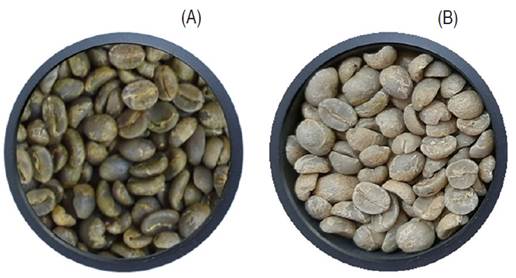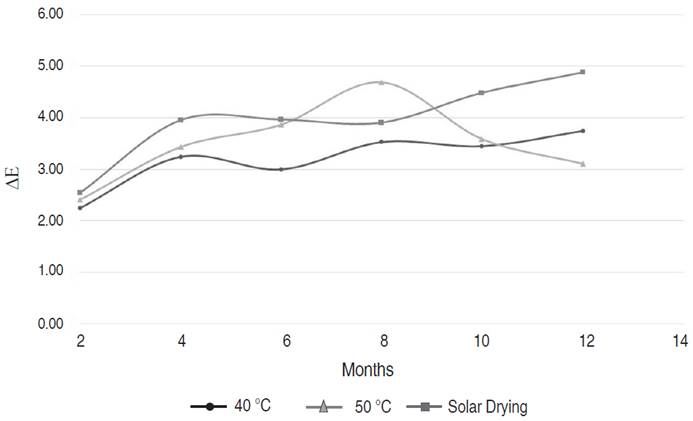The drying process for mild-washed coffees is an essential stage for maintaining the coffee quality. A decreased moisture content helps to preserve the coffee beans as this moisture loss reduces both its physiological and the microorganisms' activities, which in turn affects cleanliness, especially during storage (Broissin-Vargas et al. 2018). Washed coffee has a high moisture content (53% w.b.), which, in the shortest possible time must be reduced to preserve the quality of the beans down to levels that allow storage without deterioration, which is in the range between 10 and 12% w.b. Coffee in this state is referred to as dry parchment coffee (dpc). To achieve this stage, the natural energy of the air and solar radiation are used to dry coffee, or hot air is forced through a coffee bed in mechanical drying. In Colombia, the use of each of these systems depends on the size of the farms and coffee production. Solar drying is used more frequently on farms with production less than 3,500 kg dpc year-1, although it is also used as a backup on larger farms, in times of low production (Parra et al. 2017).
Mechanical drying is used by a small number of coffee producers who produce a large amount of coffee. It is estimated that more than 30% of annual production corresponds to approximately 27,650 coffee farms with more than 5 ha that use this type of technology (Parra et al. 2017). The large amount of coffee that is dried by coffee grower cooperatives and drying centers should also be considered; some data have suggested that more than 70% of the coffee produced in Colombia is dried mechanically (Gutiérrez et al. 2012). Given this scenery, in Colombia, recommendations and technological developments have focused on achieving the greatest technical and economic efficiency with respect to the main parameters of the mechanical equipment used to drying coffee (Parra et al. 2017; Parra-Coronado et al. 2008).
Frequently, in comparison to other dynamic dryer types, fixed bed coffee dryers are often used given their economic and maintenance advantages as well as their acceptable thermal efficiency. The dryer type involves placing two or three wet parchment coffee beds that can vary between 20 and 40 cm in thickness, in a series setup. For the fixed-bed coffee dryers, two fundamental conditions are taken into account: the air temperature and the airflow generated by the fan. Regarding the air flow, the research shows that the optimal air flow is 0.1 m3 min-1 kg-1 dpc to obtain uniformity in the final moisture of the mass that is drying (Parra et al. 2017). Regarding quality, research results show that variations in flow (0.024, 0.06, and 0.1 m3 min-1 kg-1 dpc) have no effect on cup quality (Largo 2020) or on the physiological characteristics of the bean (Alves et al. 2017; Taveira et al. 2012).
In relation to the air temperature, 50 °C is recommended to attain the lowest energy requirement, without dramatic changes in coffee bean structure. Studies reported by Roa et al. (1999) showed that an air temperature of 50 °C generated a loss of viability for 43% of the coffee seeds in the first 3 h of drying, and 95% of the seeds were maintained with germination capacity after drying at 38 °C. Sierra et al. (1990) found that germination began to decrease when the drying temperature was above 40 °C. The same authors found that this phenomenon remained independent of grain moisture and that germination was drastically reduced when the final grain moisture was below 10% w.b.
On the other hand, coffee bean color is the first indicator of physical quality since it can be observed, so it is necessary to maintain this characteristic as long as possible. However, there are some alterations noticeable after storage and transport, such as loss of color or blanching, which result in coffee receiving a lower price in the market, as the alterations are associated with a loss of quality. Thus, several investigations have focused on identifying the cause of this deterioration and exploring the association among drying, packaging, and storage conditions or their combination. Roa et al. (1992) carried out a study on storage conditions, concerned about the loss of coffee quality during this stage when the coffee is packed in fique sacks. The researchers mention that after a year coffee has a blanching defect practically anywhere in the coffee zone, especially in warm places. In the study, they found that the conditions of 15 °C and relative humidity of 65% are adequate so that the coffee in bulk does not deteriorate and they showed that the coffee stored in sacks of fique has an average of 22% discolored grains after 1 year of storage.
Different studies have shown that variations in air temperature have an effect on quality and an inverse relationship with the increase in temperature during mechanical drying, especially when the temperature exceeds 50 °C (Taveira et al. 2012; Oliveira et al. 2013; Borém et al. 2014; Alves et al. 2017). Therefore, some coffee buyers prefer coffee processed in solar dryers. The exclusive use of solar drying does not have the advantages of mechanical drying in terms of a reduction in processing time, greater volumes of processed coffee, and a decrease in risks to the quality and safety of the coffee. Solar drying is especially risky in harvest peaks because this time is characterized by low solar radiation and high relative humidity due to excessive rain, as drying time can be extended for weeks to obtain coffee within the commercial moisture range.
Regarding storage, it has been determined that the least favorable quality occurs when the temperature and the relative humidity of the environment are not controlled (Broissin-Vargas et al. 2018). Similarly, packaging coffee in fique bags generates negative effects on its physical, chemical, and physiological characteristics (Borém et al. 2014, 2019; Rendón et al. 2014). In contrast, the use of hermetic packaging allows atmospheric modification and control to preserve coffee quality, and this system has been used successfully to maintain coffee quality (Donovan et al. 2019; Borém et al. 2013; Selmar 2008).
This study was developed under the hypothesis that a mechanical drying air temperature of 50 °C generates endosperm blanching and deterioration of the quality during storage. For this, the wet coffee process, and the after-drying stages such as packaging and storage were kept constant, in order to determine the effect of drying temperature on bean color and coffee quality.
MATERIALS AND METHODS
Location
This research was conducted at the Cenicafé experimental mill, located in Chinchiná Caldas, Colombia, at an altitude of 1,310 m, with an average annual temperature of 21.2 °C and a relative humidity of 78%. Castillo® variety coffee was used, produced at altitude of 1,321 m.
Experimental design. A complete random blocks design (DRB), with 10 blocks, was used to test three treatments, which consisted of two air temperatures during mechanical drying, a fixed specific airflow, and sun-dried coffee as control:
T1: Drying with forced air at 40 °C and 0.1 m3 min-1 kg-1 dpc.
T2: Drying with forced air at 50 °C and 0.1 m3 min-1 kg-1 dpc.
T3: Solar drying in a parabolic tunnel dryer.
To maintain the specific airflow constant, a U-shaped manometer was used to measure the air static pressure before passing through the coffee layer, to be included in the Equation (1) (Oliveros and Roa 1986), with which the airflow is obtained.
Where Q is the airflow rate in m3 min-1, A the dryer area in m2, ∆p is the pressure drop occurred between the plenum and the air outlet after passing through the grain layer in cm of water column (by U manometer), M moisture in percentage and L the thickness of the coffee layer in meters. Work units of 65 kg of washed coffee (53% w.b.) were completely randomized among treatments.
Coffee processing. Approximately 500 kg of coffee fruits were processed, and the wetting process was carried out, with classification, pulping, fermenting, and washing to obtain the washed coffee (work units). The obtained washed coffee was placed under the drying conditions of each treatment, for which two fixed-bed mechanical dryers with 37.5 kg of dpc capacity were available, with electric resistances to heat the air; the solar drying treatment used a tunnel-type dryer with an area of 10 m2. During the drying process, the coffee bean's moisture, air temperature, relative humidity, and beans temperature were monitored. The drying processes ended when the coffee reached a moisture between 10.5 and 11.5% w.b.
Approximately 32.5 kg of dpc were obtained from each treatment, and this amount was stored for 15 days, after which the coffee was husked. The coffee obtained was packed and stored in double-film microperforated plastic bags in a room for 12 months at 15±1 °C and 70±5% relative humidity, according to the best storage conditions for green coffee obtained by Roa et al. (1992). Samples of 500 g were taken out every two months to perform sensory quality tests.
The response variables were the color change of the coffee beans and sensory quality. The other variables were considered complementary. The analyses performed are described below.
Colorimetry analysis. A Konica Minolta CR 410c colorimeter (Illuminant C, 2° angle) was used. The determination of the color coordinates was performed in a device with controlled illumination, focusing on the coffee sample contained in dishes with a depth of 1.5 cm. The color determination procedure was standardized using 20 g samples of healthy coffee beans without parchment retained by a 14-sieve. The value for each sample over time corresponded to the average of six measurements.
The system was programmed to work in the CIEL*a*b* color space in which there are three readings: Lightness (L*) which measures the intensity of the reflected color with values between 0 and 100, where 0 is black and 100 is white. Variable a* measures the amount of green or red in an image, being negative for green and positive for red, and the variable b* measures the amount of blue and yellow in the image, being negative for blue and positive for yellow. Since the handling of color intensities in computers is between 1 and 255 the values for a* and b* vary between -128 and 127.
To determine the color difference during storage, the magnitude of the color change was determined and defined as the numerical comparison of a sample with the standard or the initial color of the coffee. This comparison indicates the differences in each of the delta color coordinates (Δ). To estimate the total difference, delta E (ΔE*), the following Equation (2) was used:
Sensory quality analysis [SCA points]. An expert panel in coffee cupping, composed of at least three tasters with Q-Grader certificates, performed the analysis of the samples using the Specialty Coffee Association - SCA protocol, and the results showed the individual scores of each attribute and the total score received.
Coffee moisture [% w.b.]. Coffee moisture was determined by the gravimetric method in an oven, according to ISO 6673 (2003), both at the beginning and at the end of storage.
Where M is the decimal moisture on a wet basis, mi is the mass with which it enters the stove in grams, and m0 is the mass with which it reaches constant weight in grams.
Water activity - aw. This thermodynamic variable measures the susceptibility of a material to be damaged by microorganisms and is given by the following Equation 4:
Where aw is the decimal water activity, pv is the vapor pressure in the coffee beans, and pv* is the vapor pressure of pure water under the same temperature conditions. Water activity was determined using a LabMaster-aw neo (Novasina) water activity analyzer with temperature compensation.
Germination [%]. To indicate the physiological quality, 400 coffee beans were taken from the samples of each treatment, and these were divided into subsamples of 50 beans, from which the parchment or endocarp were manually removed, providing eight repetitions. The beans were moistened in excess and then placed in butter boxes for 25 days, after which the number of beans that had germinated was counted to estimate the percentage, in numbers, of germinated beans.
Fat content [% db]. The total fat content in coffee beans was determined at the beginning and end of storage by the Soxhlet method (AOAC 920.39).
Statistical analysis. The analysis was performed using the statistical program SAS version 9.4 TS Level 1M7. To analyze the color of the beans during storage, an analysis of repeated measurements was performed for each of the color coordinates, using the three drying conditions and the storage time as variation factors. From the analysis of mixed models, the best model was the one in which the covariances were adjusted under a first-order autoregressive structure. The main effect obtained was analyzed from the analysis of orthogonal polynomials to establish the behavior of the variable.
For cup quality, a 5% analysis of variance was performed taking into account the treatment or drying condition. An analysis of multiple comparisons between treatments was performed using the Tukey-Kramer test for the percentage of samples with a cup without defect. For the other variables, averages, and variations were obtained using the 5% confidence interval.
RESULTS AND DISCUSSION
The drying time for each treatment was between 16 and 21 h for 50 °C, between 41 and 49 h for 40 °C, and between 6 and 14 days for solar drying. For solar drying, the temperature recorded inside the dryer was an average of 23.8 °C, with a range from 15 to 38 °C. Similarly, the temperature of the bean in the treatments was approximately 2 °C below the drying temperature, and the smallest difference was observed at the end of the drying. The coffee moisture was between 10.8 and 11.0% w.b., as established in the methodology, corresponding to water activity values below 0.59. After 12 months of storage, the moisture of the beans remained within the commercial range (Table 1).
Table 1 Average and standard deviation (SD) for moisture (w.b.) and water activity (aw) of dry parchment coffee obtained under different drying conditions.

Both the water activity and bean moisture-maintained product stability throughout storage. This was achieved mainly due to the combination of two factors: temperature and relative humidity control and the type of packaging used, which allowed the hygroscopic equilibrium conditions of the green coffee bean to be maintained, as determined by Trejos-Rodríguez et al. (1989). Studies conducted by Donovan et al. (2019) with different types of packaging demonstrated that in comparison to jute packaging, double film packing helps to protect the coffee, preventing changes in moisture during storage. Jute packaging in combination with storage under variable conditions of humidity and temperature that occur naturally in the environment generates color change, an increase in the populations of filamentous fungi, and a loss of general quality (Borém et al. 2019; Broissin-Vargas et al. 2018).
Coffee bean color analysis
After drying, a coffee bean has a characteristic bluish-green color when it has a moisture close to 11% w.b. This color tends to be lighter, turning green-yellow when it has a moisture lower than 10%, because this color indicates the beans are over dry and is considered a physical defect of coffee that is easily detected after drying. This scenario did not occur in this study since the coffee obtained by the different drying methods presented moisture levels close to 11% and were comparable. The differences in color resulting from the treatments occurred mainly in the beans obtained by solar drying. The a* and b* values indicated that this type of bean presented a more green and yellow coloration from the beginning of storage, probably due to the degradation of coffee pigments generated during drying with exposure to solar radiation, which does not occur when the coffee is mechanically dried as it is confined in a space without light exposure.
Tables 2, 3, and 4 show the coordinates L*, a* and b* color values, with respect to the storage time. The analysis of repeated measurements performed for each of the color coordinates showed a significant effect for the luminosity coordinate (L*) due to the effect of storage time (P<0.001), indicating a lighter color after 12 months with respect to the initial color. For coordinates a* and b*, there was a significant effect for the treatment and storage time factors (P<0.001, for both cases) but not for the interaction P=0.6410 and P=0.9688 for a* and b*, respectively. This result indicates that the changes in these color coordinates occurred by the effects of drying or storage, and not by their combination.
Table 2 Average and standard deviation (SD) for variable L* according to storage time and type of drying.
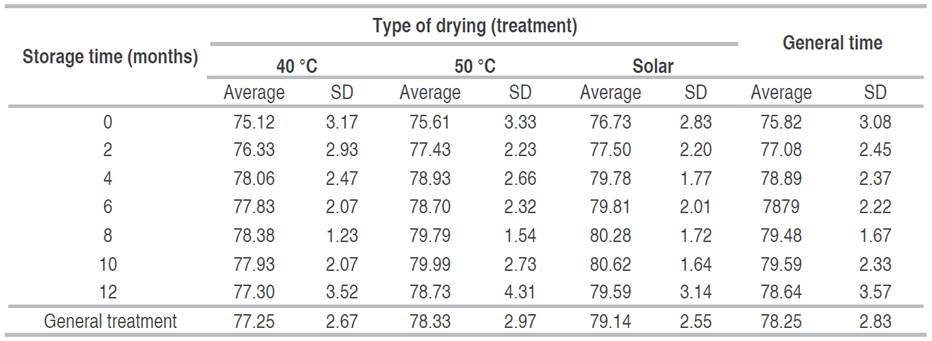
Table 3 Average and standard deviation (SD) for variable a* according to storage time and type of drying.
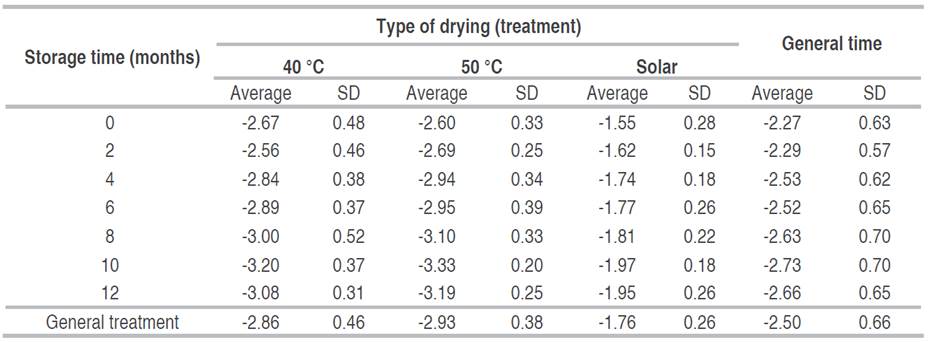
Table 4 Average and standard deviation (SD) for variable b* according to storage time and type of drying.
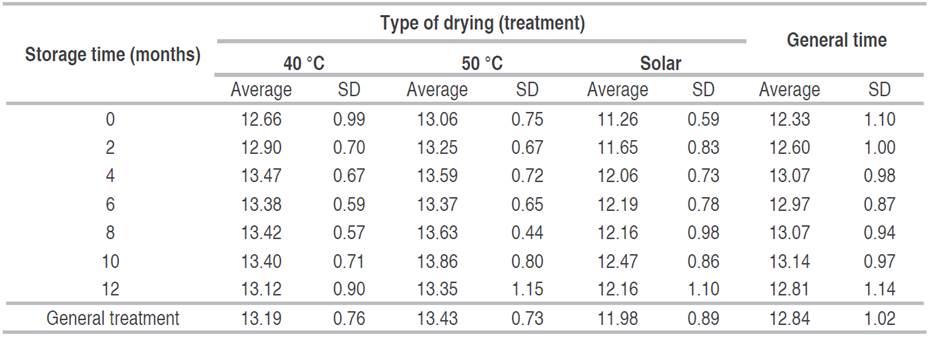
Discoloration in beans or bleaching was perceived, in all the treatments, after several months of storage (Figure 1). Previous studies have shown that changes in a* and b* coordinates values, from green-yellow to very light yellow, indicate oxidative processes and biochemical degradation. These changes cause differences in flavor and aroma precursor compounds composition that are reflected in a loss of final quality, related to effects on the bean that occurred during processing, drying, packaging, and storing under different conditions (Borém et al. 2019; Broissin-Vargas et al. 2018; Abreu et al. 2015; Borém 2014).
Complementary to the above, the magnitude of the color change encompassed the three coordinates (∆E), which increased with storage time, but this increase was lower for coffee obtained at 40 °C (Figure 2). The values obtained for the first two months were similar for the three treatments, which indicates that color changes were more easily perceived after four months, especially for coffee obtained by solar drying; however, the color changed during the last two evaluation periods, with the solar drying treatment presenting the greatest color change with respect to the initial color. A maximum color change was also observed after eight months of storage for coffee at 50 °C, which may indicate maximum deterioration of the bean, while for the other treatments, the color change continued.
Sensory quality
From each treatment and rep, samples were taken at 0, 2, 4, 6, 8, 10 and 12 months to evaluate sensory quality based on the SCA score. Additionally, the proportion of clean cups was calculated for each treatment.
The coffee obtained by drying conditions was comparable quality since no significant differences were found due to the effect of the treatments (P=0.3042), as the quality value was close to 81 SCA points (Table 5). This result indicates that the differences in drying did not allow to easily perceive differences in quality, at least at the beginning of storage.
Table 5 Average and confidence interval for the sensory quality analysis (SCA points) for the coffee obtained under different drying conditions during storage.

During storage, 186 samples were obtained for sensory analyses. 65% of the samples had no defects in the cup, maintaining a score with an average higher than 80 SCA points (Table 5). However, all the samples of the 50 °C treatment showed defects after 8 months. Therefore, there were not samples to send for cup quality analyses for the months 10 and 12.
A generalized linear model was used to evaluate the proportion of clean cups related to the type of drying and storage. This model was conducted by assuming a response variable with binomial distribution and logit as a link function. As a result, type of drying was significant (P=0.0006).
The multiple comparison Tukey-Kramer performed on the proportion of treatment samples with a clean cup showed a significant effect (P=0.0098) between the two temperatures used for mechanical drying, with the probability of obtaining a clean cup during storage being significantly higher when the coffee was dried at 40 °C. Similarly, the comparison between 50 °C coffee and solar drying in terms of a clean cup was significant, favoring the latter (P=0.0005). The difference between 40 °C and solar drying was not significant (P=0.1141).
These results are consistent with the results obtained by Largo (2020), in which the coffee quality from mechanical drying at 40 °C and by a solar dryer did not present significant differences in terms of clean cups. However, Suárez et al. (2018) obtained the best coffee quality with drying at 50 °C compared to that obtained with solar drying and different temperatures and pre-drying times. This result can be explained by the bean cellular structure. Studies carried out by Borém et al. (2008), in which the plasma membrane integrity was observed in the endosperm cells in coffee beans that were dried at 40 °C, while the beans dried at 50 °C disorganized bean membrane system was identified. Consequently, could have been related to the lower quality and damage caused by the temperature during drying.
The photographs (Scanning Electron Microscope, SEM) show the bean structure taken with a zoom of 100 µm (Figure 3). The more defined porous structure of the coffee bean can be observed and corresponds to solar drying. This structure was lost with mechanical drying, especially with the higher drying temperature.

Figure 3 Scanning electron microscopy of coffee beans obtained under different drying conditions. (A) Mechanical drying at 50 °C, (B) mechanical drying at 40 °C, and (C) solar drying.
A relationship was also found between the coffee fruits maturity and 50 °C drying air temperature. When were present more than 70% of overripe fruits, color 7 in Cromacafé® (Peñuela-Martínez et al. 2022) there was a greater probability of presenting a fermented defect that had become more evident with storage advancement. In studies conducted by Velásquez et al. (2021), some physical characteristics of coffee beans from different ripeness states were found to influence the thermodynamic properties, which affected the drying behavior, especially when the drying rate was constant. In this study, it was shown that color 7, which corresponds to the overripe coffee fruit, presented the greatest differences, which was related to the greater susceptibility of the bean to moisture loss under certain drying conditions, such as high temperatures. These differences were associated with damage of endosperm cell's structure (Borém et al. 2008, 2013) and releasing the lipids. The lipids are unsaturated fatty acids approximately 50% that are easily oxidized and alter the coffee composition (Rendón et al. 2014) then perceived as a fermented defect in coffee beverage.
Additionally, the drying conditions generated differences in bean germination (Figure 4A), which was lower with 50 °C. These beans showed greater susceptibility to contamination by filamentous fungi during the germination tests, probably due to deterioration of the embryo and the loss of the cell wall under this condition. In a coffee bean, the heat generated during drying affects the embryo; therefore, this is indirect evidence that the seed physiological quality can be related to the quality of the coffee, especially when washed coffees are processed (Alves et al. 2017; Oliveira et al. 2013).

Figure 4 Averages and confidence intervals for the variables related to physiological quality of the beans. (A) Percent germination and (B) total fat content at the beginning and end of storage.
Complementary to the above, the fat content in coffee can also indicate deterioration of bean cellular structure since an inverse relationship has been identified between this variable and sensory quality (Rendón et al. 2014; Oliveira et al. 2013). In Figure 4B, coffee dried at 50 °C had the highest average total fat content from the beginning of storage. This behavior was stable until the storage end. In addition, the other treatments resulted in an increase in the total fat content, which was especially noticeable for the solar-dried coffee for which the amount equaled the levels obtained for the coffee dried at 50 °C. These results can be related to the magnitude of the color change, which reached the highest levels for solar-dried coffee at the end of storage (Figure 2). Similarly, coffee dried at 40 °C showed the lowest change in fat content during storage.
CONCLUSIONS
The aim of storage is to maintain the quality of the coffee until the end of the marketing and distribution chain. The conditions under which the coffee was stored during this research work allowed the beans to be maintained at hygroscopic equilibrium humidity, due to the type of packaging used.
Some physical changes were observed in the beans stored in this study, the most notable being color. Changes were observed in the L* coordinate, which represents the clarity of the grains, with a positive rate of about 3 units year-1 difference in the time that corresponded to this research work, for the three treatments. Therefore, there was no association of drying temperature or type of drying with the change in clarity during storage. This led to the conclusion that color degradation processes are normal and difficult to control.
Regarding the mechanical drying process at a temperature of 50 °C, it was observed that the coffee suffered deterioration during storage, resulting in a change in color and loss of quality, corroborating the hypothesis of bleaching in the endosperm generated at a temperature of 50 °C, in addition to the degradation of quality during storage. In addition, the coffee obtained by solar drying presented the greatest color degradation, noticeable at the beginning of storage; however, this change was not related to the quality, since it was comparable to that obtained by coffee dried at 50 °C, in addition to the deterioration of quality during storage.


















